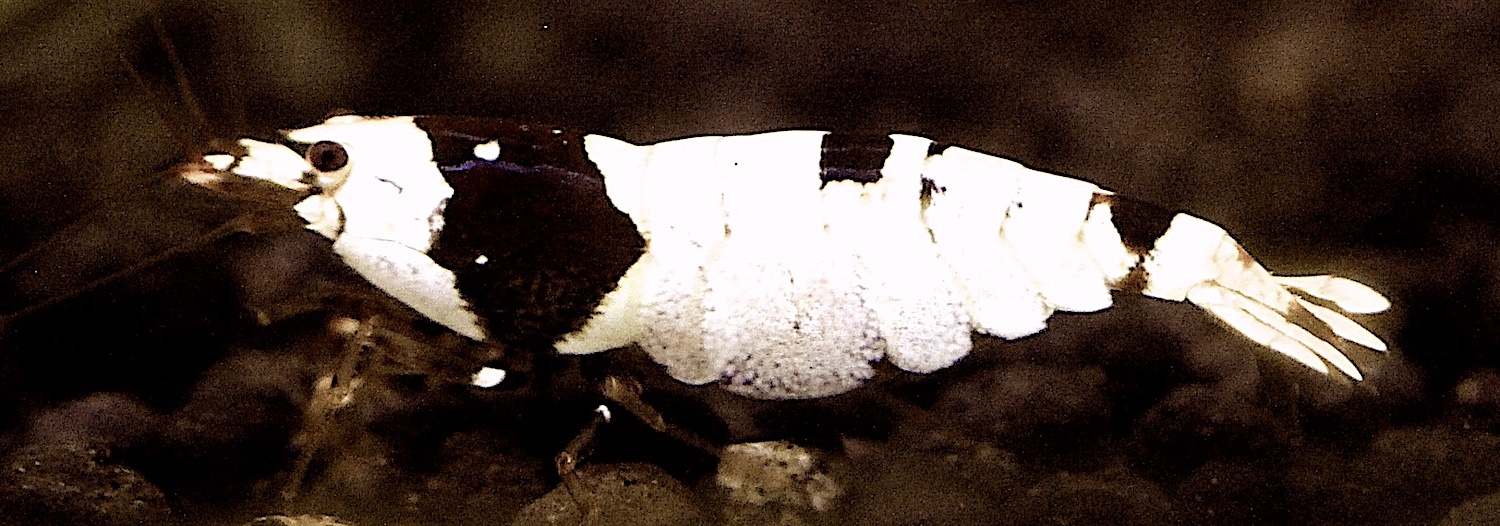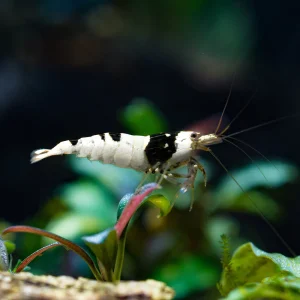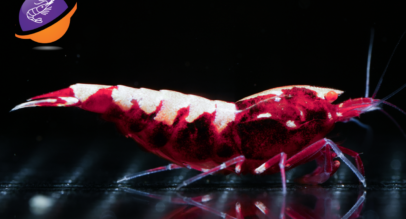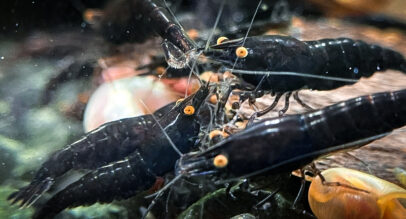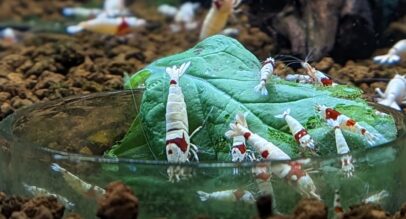Crystal Black Shrimp PBL, or Pure Black Line, represent a fascinating development in the world of ornamental shrimp. These shrimp are a specialized strain derived from Crystal Black Shrimp, bred for their distinctive coloration and genetic stability.
PBL shrimp feature a predominantly white, opaque body adorned with unique black patterns. Unlike standard Crystal Blacks, they typically have fewer full black bands. Instead, they showcase intricate black markings on their heads, sometimes forming interesting shapes like crowns, smileys, or flowers.
What truly sets PBL shrimp apart is their breeding consistency. They carry no recessive red genes, ensuring that offspring maintain the characteristic black and white coloration. This genetic purity makes them highly sought after by enthusiasts and breeders alike.
Scientific Name and Classification
The scientific name of Caridina Pure Black Line shrimp is Caridina cantonensis. These shrimp belong to the family Atyidae within the order Decapoda. They share a close genetic lineage with other popular shrimp varieties such as the Crystal Black/Red Shrimp and other selectively bred Caridina species.
Origin and Natural Habitat
Caridina Pure Black Line shrimp are originally derived from wild populations found in the freshwater rivers and streams of Southeast Asia, particularly in regions of China and Taiwan. These natural habitats are characterized by soft, slightly acidic water with abundant vegetation and slow-moving currents. The environments provide ample hiding places and a rich source of biofilm and microorganisms, essential for their diet.
Physical Appearance, Size, and Lifespan
Pure Black Line (PBL) shrimp are a distinctive strain of Crystal Black shrimp, known for their unique coloration. These shrimp typically reach an adult size of about 30mm (1.2 inches). Their body is predominantly white and opaque, setting them apart from standard Crystal Blacks. Unlike their name, PBLs don’t feature full black coloration. Instead, they showcase intricate black spots on their head, which can form interesting patterns such as crowns, smileys, or flowers. This combination of white body and black markings creates a striking contrast. One of the key characteristics of PBL shrimp is their genetic stability. They don’t carry recessive red genes, ensuring that all offspring maintain the distinctive black and white coloration. This trait makes them highly valued among shrimp enthusiasts and breeders. On average, PBL shrimp have a lifespan of 1 to 2 years. With proper care and optimal conditions, these shrimp can thrive in aquarium settings, offering aquarists a unique and visually appealing addition to their tanks.
History of Caridina Pure Black Line Shrimp (PBLs)
Development Through Selective Breeding
The distinct appearance of Caridina Pure Black Line shrimp is a product of extensive selective breeding programs. Breeders meticulously selected shrimp with the darkest pigmentation and bred them over multiple generations to achieve the deep black coloration that PBLs are known for today. This process required careful attention to genetics and environmental conditions to enhance and stabilize the desired traits.
Relation to Crystal Black Shrimp
Caridina Pure Black Line shrimp share a close genetic relationship with the Crystal Black Shrimp (CRS), another highly prized variety within the Caridina genus. Both types originated from the wild Caridina cantonensis but were selectively bred for different colorations—CRS for their vibrant Black and white patterns, and PBLs for their solid black appearance. The techniques and knowledge gained from breeding CRS have significantly contributed to the successful development of PBLs.
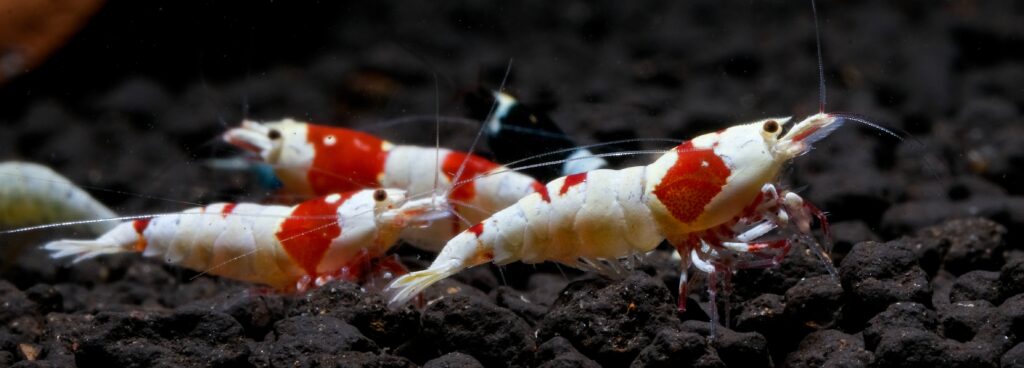
Caridina Pure Black Line Shrimp (PBLs) Care and Ideal Water Parameters
To maintain healthy and vibrant Caridina Pure Black Line shrimp, it is crucial to provide them with optimal water conditions that mimic their natural habitat. The following parameters are recommended for their care:
- TDS (Total Dissolved Solids): 100-120 ppm
- pH: 5.4-6.2
- GH (General Hardness): 4-5 dGH
- KH (Carbonate Hardness): 0-1 dKH
- Temperature: 60-72°F (15.5-22°C)
These parameters ensure that the water remains soft and slightly acidic, similar to the conditions in their natural environment. Regular monitoring and maintenance of water quality are essential to prevent stress and promote the overall health and longevity of the shrimp. Providing a well-planted tank with plenty of hiding spots and a stable environment will help PBLs thrive and display their best coloration.
Setting Up a Successful Caridina Pure Black Line Shrimp (PBLs)
Tank Size Recommendations
When setting up a tank for Caridina Pure Black Line shrimp, it’s important to choose an appropriate size to ensure their well-being. A minimum tank size of 5 gallons (19 liters) is recommended for maintaining a stable environment and providing enough space for the shrimp to thrive. Larger tanks, such as 10 gallons (38 liters) or more, are even better, as they offer more stable water parameters and greater space for the shrimp to explore.
Filtration Options
Filtration is crucial for maintaining water quality in a shrimp tank. Sponge filters are particularly popular among shrimp keepers for several reasons:
- Gentle Filtration: Sponge filters provide gentle water movement, which is ideal for shrimp that are sensitive to strong currents.
- Biological Filtration: The sponges offer a large surface area for beneficial bacteria to colonize, aiding in the breakdown of harmful waste products.
- Safe for Shrimp: Sponge filters are safe for baby shrimp (shrimplets) as they do not get sucked into the filter.
 Substrate Choices
Substrate Choices
Choosing the right substrate is vital for Caridina Pure Black Line shrimp. Active substrates, such as ADA Aqua Soil or similar products, are highly recommended. These substrates help maintain the slightly acidic pH levels (5.4-6.2) and soft water conditions that Caridina shrimp prefer. Additionally, they provide a natural-looking environment and support plant growth, which benefits the overall tank ecosystem.
Importance of Hiding Places and Plants
Hiding places and plants are essential for creating a comfortable and stress-free environment for Caridina Pure Black Line shrimp. Including a variety of live plants, such as Java moss, Anubias, and ferns, not only enhances the aesthetic appeal of the tank but also offers hiding spots and surfaces for biofilm growth. Additionally, adding driftwood, rocks, and shrimp caves provides shelter and helps the shrimp feel secure.
Acclimation Process
Proper acclimation is crucial to ensure the shrimp adjust smoothly to their new environment. The drip acclimation method is highly recommended:
- Float the Bag: Float the shrimp bag in the tank for 15-20 minutes to equalize the temperature.
- Start Drip Acclimation: Use an airline tube to slowly drip tank water into the shrimp bag or container, approximately 1-2 drops per second.
- Monitor and Transfer: After 1-2 hours, once the volume of water in the bag has tripled, gently net the shrimp and transfer them to the tank.
Diet and Feeding
Natural Feeding Habits
In their natural habitat, Caridina Pure Black Line shrimp are scavengers, feeding on biofilm, algae, and detritus. This diverse diet provides them with essential nutrients and promotes their health and vibrant coloration.
 Recommended Commercial Foods
Recommended Commercial Foods
To supplement their natural diet, high-quality commercial shrimp foods are recommended. Look for foods specifically formulated for Caridina shrimp, such as:
- Shrimp pellets
- Algae wafers
- Specialized Caridina shrimp food
These products are designed to provide balanced nutrition and support overall health.
Supplemental Foods
In addition to commercial foods, offering supplemental foods can enhance the shrimp’s diet:
- Blanched Vegetables: Zucchini, spinach, and cucumber.
- Leaves: Indian almond leaves (Catappa leaves) and oak leaves.
- Protein Supplements: Occasional treats like freeze-dried bloodworms or brine shrimp.
Feeding Frequency and Amount
Feed 2-3 times a week, an amount that the shrimp can consume within 1-2 hours. Avoid overfeeding to maintain water quality and prevent food from fouling the tank.
Understanding Caridina Pure Black Line Shrimp (PBLs)
Basic Principles of Caridina Pure Black Line Shrimp (PBLs) Grading
Grading Caridina Pure Black Line shrimp involves assessing their coloration, pattern, and overall quality. Higher-grade shrimp exhibit more intense black coloration, distinct white bands, and uniform patterns. The grading system helps breeders and hobbyists identify the best specimens for breeding and sales.
Importance of Grading in Breeding and Sales
Grading is crucial for maintaining and improving the quality of Caridina Pure Black Line shrimp. It ensures that only the best specimens are used for breeding, which helps enhance desired traits in future generations. Additionally, higher-grade shrimp typically command higher prices in the aquarium trade, making grading an essential aspect of shrimp sales.
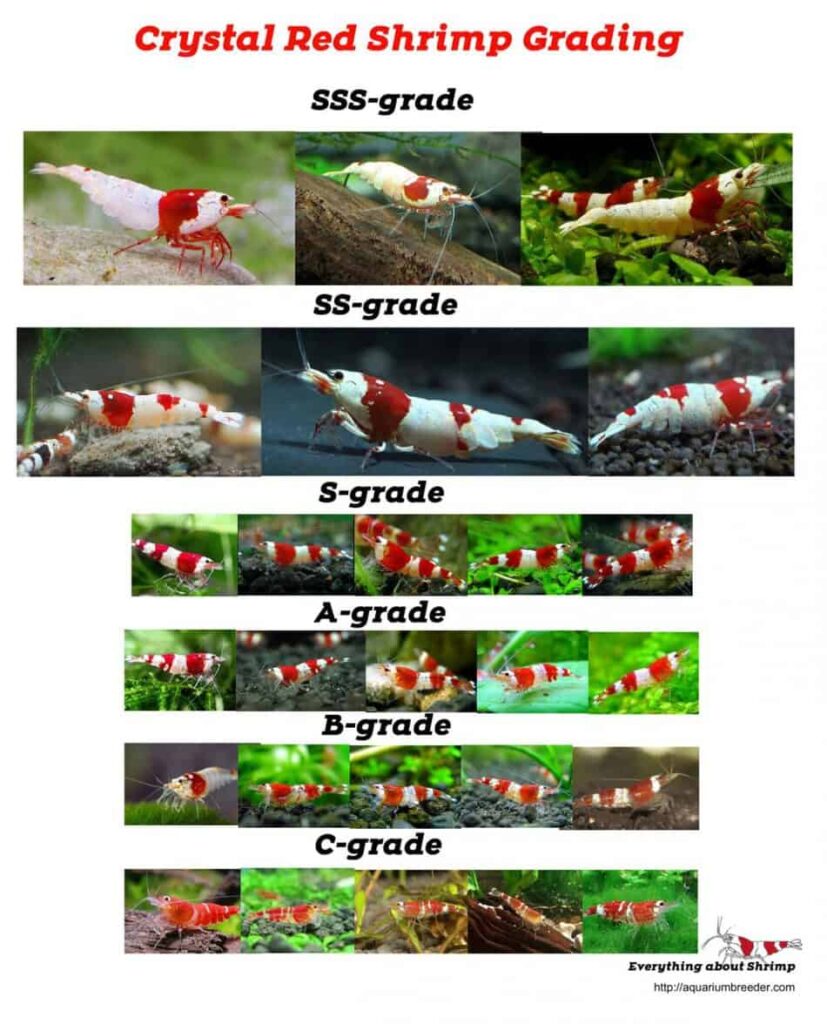
Color Grading
Description of Different Color Grades
Caridina Pure Black Line shrimp (PBLs) are graded based on the intensity and uniformity of their coloration. The grading system ranges from lower to higher grades, typically labeled as C, B, A, S, SS, and SSS. Here’s a brief overview:
C: Shrimp has mostly solid black body with minimal white. Colors appear washed out.
B: Faint white stripes but black is still dominant. Lacks color vibrancy.
A: Even amounts of white and black. White has decent opacity, black appears blotchy.
S: White is the primary color. black areas are solid/intense. Some patchiness between colors.
SS: Very intense, evenly spread opaque white. Solid vivid black remains on segments. Non-transparent leg coloration.
SS+: Solid white dominates with even less transparency than SS grade. Clean colors. Solid leg coloration.
SSS: Virtually no transparent spots on the shell – shrimp is an opaque pure white with minimal black patterns. Leg coloration is equally as clean and thick.
SSS+: Considered an ideal specimen with seamless solid white to the naked eye, no transparency whatsoever. Vivid and distinct black patterns. 100% colored legs.
Factors Affecting Color Intensity
Several factors influence the color intensity of Caridina Pure BlackLine shrimp:
- Genetics: Inherited traits from high-grade parents result in better color.
- Diet: A nutritious diet rich in carotenoids and other color-enhancing compounds can intensify black hues.
- Water Quality: Optimal water parameters and cleanliness prevent stress and promote vibrant coloration.
- Lighting: Adequate and appropriate lighting can enhance the visual appearance of the shrimp’s colors.
Pattern Grading
Intro to Types of Patterns
Caridina Pure Black Line shrimp also exhibit a variety of patterns, which contribute to their grading and value. Common patterns include:
- No Entry: A solid black body with no entry sign patterns on the head.
- Hinomaru: A black circle or dot on the shrimp’s back, resembling the Japanese flag.
- Mosura: Mostly white body with black markings, often on the head and tail.
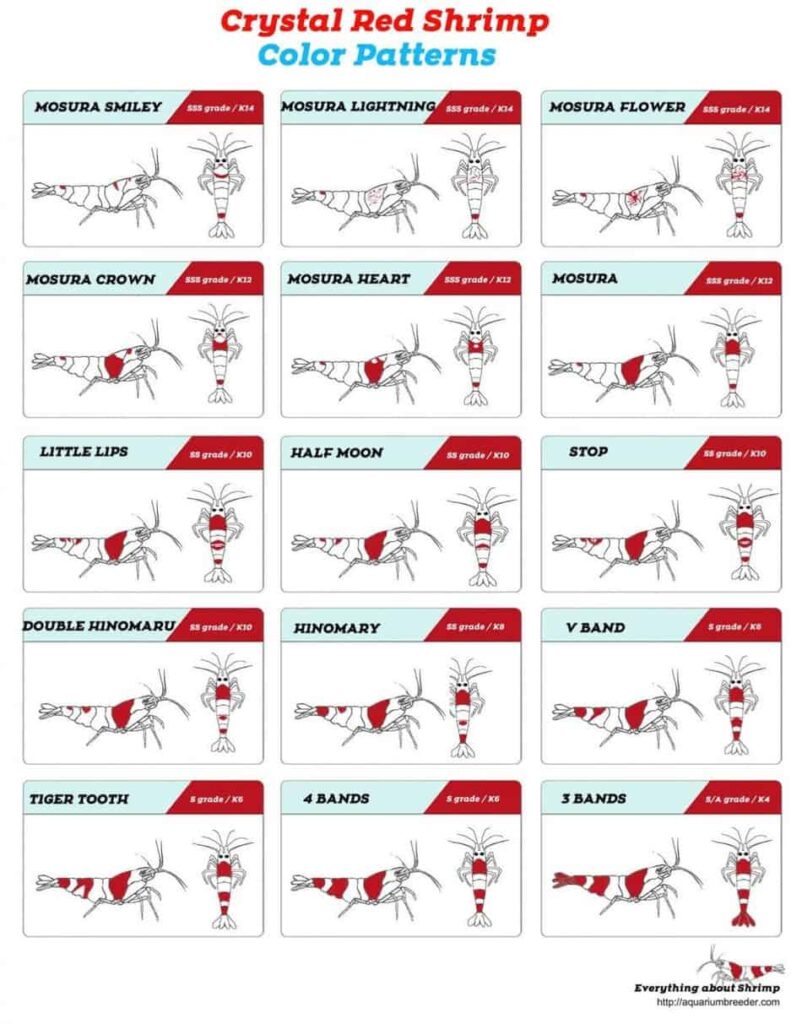
Rarity and Value of Different Patterns
Patterns significantly affect the rarity and value of the shrimp. For example, Mosura patterns are often more sought after due to their striking contrast and unique appearance, making them more valuable. Hinomaru patterns are also highly prized for their distinctive look. The No Entry pattern is less common but still valued for its simplicity and beauty.
For a comprehensive guide on grading the patterns of Caridina Pure Black Line shrimp, check out our detailed Caridina Pure Black Line Shrimp Grading Guide.
Breeding Caridina Pure Black Line Shrimp (PBLs)
Breeding Setup Requirements
To successfully breed Caridina Pure Black Line shrimp, a dedicated breeding tank is recommended. Key requirements include:
- Tank Size: A minimum of 10 gallons (38 liters) is suitable.
- Water Parameters: Maintain optimal water conditions with a pH of 5.4-6.2, TDS of 100-120 ppm, GH of 4-5, and KH of 0-1.
- Substrate: Use an active substrate to stabilize water parameters.
- Filtration: Sponge filters are ideal to provide gentle filtration and safe environments for shrimplets.
Mating Behavior
Caridina Pure Black Line shrimp exhibit a predictable mating behavior. Females release pheromones when ready to mate, attracting males who swim actively around the tank in search of a receptive female. Successful mating results in the female carrying fertilized eggs under her abdomen.
Egg Development and Hatching
After mating, the female carries the eggs for approximately 30 days. The eggs develop and change color, typically becoming darker as they near hatching. Once hatched, the tiny shrimplets resemble miniature versions of the adults and immediately begin scavenging for food.
Care for Shrimplets
Providing a safe and nutritious environment is crucial for the survival and growth of shrimplets:
- Food: Offer powdered foods and biofilm to support their dietary needs.
- Water Quality: Maintain pristine water conditions with regular water changes and careful monitoring.
- Hiding Places: Ensure ample hiding spots with plants and moss to protect shrimplets from potential stress.
By meeting these conditions, breeders can successfully raise healthy Caridina Pure Black Line shrimp.
Common Health Issues and Treatments
Signs of Stress or Illness
Identifying stress or illness in Caridina Pure Black Line shrimp (PBLs) is crucial for maintaining a healthy colony. Common signs include:
- Lethargy: Reduced activity or hiding excessively.
- Color Loss: Fading or dulling of their vibrant black coloration.
- Erratic Swimming: Unusual swimming patterns or frequent attempts to climb out of the tank.
- Visible Parasites: Small white or brown spots on their body.
- Molting Issues: Difficulty shedding their exoskeleton or incomplete molts.
Common Diseases and Parasites
- Bacterial Infections: Symptoms include lethargy, color loss, and cloudy exoskeleton. Often caused by poor water quality.
- Fungal Infections: White or cotton-like growths on the body or legs.
- Vorticella: White, fuzzy patches usually around the head and antennae.
- Planaria and Hydra: Small, flatworms and stinging organisms that can harm shrimplets.
- Parasitic Infections: Ellobiopsidae (green fungus) and other parasitic invaders causing visible growths or lesions.
Prevention and Treatment Options
- Water Quality Maintenance: Regular water changes and monitoring of parameters to prevent stress-related diseases.
- Quarantine New Additions: Isolate new shrimp or plants before introducing them to the main tank.
- Medication: Use shrimp-safe medications like anti-fungal or anti-bacterial treatments for infections.
- Manual Removal: For parasites like Planaria and Hydra, manual removal and traps can be effective.
- Salt Baths: Short salt baths can help treat external parasites, but must be done carefully to avoid stress.
Compatible Tank Mates
Suitable Shrimp Species
- Crystal Black Shrimp (CRS): Similar water parameter requirements make them ideal companions.
- Caridina Taiwan Bee Shrimp: Includes varieties like Blue Bolt and King Kong.
- Amano Shrimp: Larger but peaceful, good for algae control.
Compatible Fish Species
- Small Tetras: Neon or Ember Tetras are non-aggressive and small enough not to pose a threat.
- Otocinclus Catfish: Gentle algae eaters that coexist peacefully with shrimp.
- Pygmy Corydoras: Small and peaceful bottom dwellers.
Add fish with caution, small shrimp may become food. No fish are not recommended in a breeding colony.
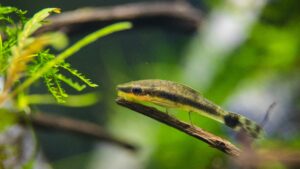
Species to Avoid
- Large or Aggressive Fish: Such as cichlids, bettas, and large gouramis, which can prey on shrimp.
- Goldfish: Their constant foraging behavior can stress and potentially harm shrimp.
- Crayfish: Aggressive and predatory towards smaller tank mates.
FAQs
Can Caridina Pure Black Line Shrimp (PBLs) Be Kept with Crystal Black Shrimp?
Yes, Caridina Pure Black Line Shrimp can be kept with Crystal Black Shrimp (CRS). Both species have similar requirements for water parameters and tank conditions, making them compatible tank mates.
Can Caridina Pure Black Line Shrimp (PBLs) Be Kept with Fish?
Yes, but it’s important to choose small, non-aggressive fish species. Suitable options include small tetras, Otocinclus catfish, and pygmy Corydoras. Avoid large or predatory fish that might harm the shrimp.
*No fish are not recommended in a breeding colony.
How Long Do Caridina Pure Black Line Shrimp (PBLs) Live?
Caridina Pure Black Line Shrimp typically live for 1.5 to 2 years under optimal conditions. Proper care, including stable water parameters and a nutritious diet, can help maximize their lifespan.
How Often Do Caridina Pure Black Line Shrimp (PBLs) Molt?
Molting frequency varies depending on age, diet, and water conditions. Juveniles molt more frequently, every few weeks, while adults may molt monthly. Molting is essential for growth and health.
What Causes Caridina Pure Black Line Shrimp (PBLs) to Lose Color?
Color loss in Caridina Pure Black Line Shrimp can be caused by several factors, including stress, poor water quality, inadequate diet, and improper lighting. Ensuring optimal conditions and a balanced diet helps maintain their vibrant coloration.
Buying Guide
How to Spot Healthy Shrimp
When purchasing Caridina Pure Red Line Shrimp (PBLs), it’s crucial to identify healthy specimens to ensure a thriving tank. Look for the following indicators:
- Vibrant Coloration: Healthy shrimp exhibit intense red hues with clear, defined patterns.
- Active Behavior: Look for shrimp that are actively swimming or foraging. Avoid those that appear lethargic or stationary for long periods.
- Clear Exoskeleton: The exoskeleton should be free of any white spots, cloudy patches, or discoloration.
- Intact Antennae and Legs: Ensure that the shrimp’s antennae and legs are intact and free from damage or signs of regrowth.
Selecting the Best Specimens
To select the best Caridina Pure Red Line Shrimp:
- Check for Juveniles: Juvenile shrimp adapt more easily to new environments and have a longer lifespan ahead.
- Observe Patterns: Choose shrimp with clear, distinct patterns and no signs of fading or irregularities.
- Inspect the Tank: Ensure the holding tank is clean and well-maintained, indicating good care practices by the seller.
Reputable Sources for Purchasing Caridina Pure Red Line Shrimp (PBLs)
It’s important to buy from reputable sources to ensure the health and quality of your shrimp:
- Specialized Breeders: Look for breeders who specialize in Caridina shrimp and have a good reputation within the community. Target reputable lineages. In breeding colonies, purebred or near purebred lineages are vital to ensure consistent offspring and predictable gene inheritance, free from genes of other variants.
- Online Retailers: Choose well-reviewed online stores known for their quality livestock and reliable shipping practices.
- Local Fish Stores (LFS): Some LFS may carry high-quality Caridina shrimp. Ensure they have knowledgeable staff and a good selection.
Shipping Considerations
When ordering shrimp online, consider the following to ensure they arrive healthy:
- Express Shipping: Opt for overnight or express shipping to minimize transit time and stress.
- Insulated Packaging: Ensure the seller uses insulated packaging to maintain temperature during transit.
- Heat or Cold Packs: Depending on the season, appropriate temperature regulation should be included.
- Acclimation Instructions: Follow any provided acclimation instructions carefully to reduce stress and ensure a smooth transition into your tank.
Contact us at hello@rareshrimp.com if you are looking to buy Caridina Pure Red Line Shrimp (PBLs).
Advanced Caridina Pure Red Line Shrimp (PBLs) Keeping
Selective Breeding Techniques
Selective breeding involves pairing shrimp with desirable traits to enhance specific characteristics in the offspring:
- Identify Desired Traits: Choose traits such as color intensity, pattern clarity, and size.
- Isolate Breeding Pairs: Set up separate breeding tanks for selected pairs to control genetic outcomes.
- Track Lineages: Keep detailed records of breeding pairs and offspring to monitor progress and maintain genetic diversity.
Creating Unique Color Morphs
Advanced keepers may experiment with creating new color morphs through selective breeding:
- Cross-Breeding: Pair Caridina Pure Red Line Shrimp with other Caridina varieties to introduce new colors and patterns.
- Genetic Line Breeding: Focus on enhancing and fixing new traits by breeding related shrimp with desirable characteristics over several generations.
- Mutation Observation: Occasionally, spontaneous mutations occur. Isolate and breed these individuals to develop unique morphs.
Participating in Shrimp Competitions
Shrimp competitions offer a platform to showcase breeding achievements and connect with other enthusiasts:
- Prepare Your Shrimp: Ensure your shrimp are in peak condition with vibrant colors and clear patterns.
- Follow Entry Guidelines: Adhere to competition rules regarding shrimp size, color, and presentation.
- Network with Peers: Use competitions as an opportunity to learn from other breeders and gain recognition in the community.
Caridina Pure Red Line Shrimp (PBLs) are a captivating addition to any freshwater aquarium, known for their striking coloration and engaging behaviors. Maintaining these shrimp requires attention to detail in water parameters, diet, and tank setup. With proper care, these shrimp can thrive and even breed successfully, adding an extra dimension of interest and beauty to your aquarium.
By following the guidelines provided in this article, you can create a healthy and thriving environment for your Caridina Pure Red Line Shrimp. Whether you are a novice or an advanced shrimp keeper, these shrimp offer endless opportunities for enjoyment and discovery. So, dive into the world of Caridina Pure Red Line Shrimp and experience the satisfaction of keeping these exquisite creatures.

